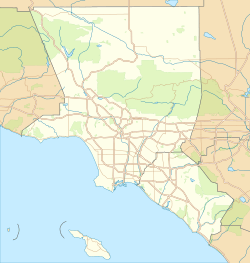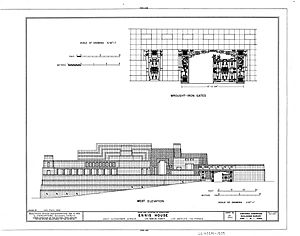Ennis House facts for kids
|
Ennis House
|
|
 |
|
| Location | 2607 Glendower Ave Los Angeles, California |
|---|---|
| Built | 1924 |
| Architect | Frank Lloyd Wright |
| Architectural style | Mayan Revival, Textile Block |
| NRHP reference No. | 71000145 |
Quick facts for kids Significant dates |
|
| Added to NRHP | October 14, 1971 |
The Ennis House is a famous house in Los Angeles, California. It is located in the Los Feliz neighborhood, near Griffith Park. The famous architect Frank Lloyd Wright designed this house for Charles and Mabel Ennis. It was built in 1924.
The Ennis House is one of Wright's "textile block" designs. These homes are made from special interlocking concrete blocks. It is the largest of these four homes in the Los Angeles area. The other three are the Millard House, the Storer House, and the Freeman House.
The design of the Ennis House looks like ancient Maya temples. This style is called Mayan Revival architecture. The house has about 27,000 concrete blocks. These blocks have detailed patterns inspired by old Mayan buildings in a place called Uxmal.
The Ennis House is a very important building. It is a landmark for the city, state, and country. From 2011 to 2019, a rich businessman named Ronald Burkle owned it.
Contents
History of the Ennis House
The Ennis House is actually made of two buildings. There is the main house and a smaller apartment for a driver, which also has a garage. These two parts are separated by a paved courtyard.
The house is very big, about 10,000 square feet. It has a long hallway on the north side. This hallway connects all the different rooms. These rooms include the kitchen, dining room, living room, and several bedrooms and bathrooms.
Building the house was not easy and cost a lot of money. Frank Lloyd Wright's son, Lloyd Wright, first oversaw the construction. But the owners took over after a while. They even made some changes to Wright's original plans.
In 1940, a media person named John Nesbitt bought the house. He asked Wright to add a swimming pool, a billiard room, and a heating system.
For a long time, the house was known as the "Ennis-Brown House." This name was given in 1980. It was to thank Augustus O. Brown, who owned the house and later gave it to a special group called the Trust for Preservation of Cultural Heritage. But in 2005, the house went back to its original name, the Ennis House. The group that owned it also changed its name to the Ennis House Foundation.
The Foundation owned the house for many years, from 1980 to 2011. During this time, the house became very famous. It was used as a filming location for many movies and TV shows.
In 2009, the Ennis House Foundation decided to sell the house. They first asked for $15 million. But because the economy was not good, the price went down. In 2011, business executive Ron Burkle bought it for about $4.5 million. A special rule was part of the sale: the public must be allowed to visit the house 12 days a year. This rule applies to anyone who buys the house in the future. In 2019, Burkle sold the house for $18 million.
Restoring the House
Even when it was still being built, the Ennis House had problems. The concrete blocks started to crack. The lower walls also began to bend. The special granite used to color the blocks had natural impurities. This, along with air pollution, caused the concrete to break down too quickly. Even trying to protect the house with coatings caused more issues.
More damage happened during the 1994 Northridge earthquake. Also, there was a lot of rain in 2004 and 2005. The Ennis House Foundation thought it would cost $5 million just to make the building safe. A full restoration would cost $15 million. After the heavy rains, the house was briefly marked as "no entry." Later, it was changed to "limited entry." There was also serious damage to a wall at the back of the house. In 2005, the house was put on a list of "11 Most Endangered Historic Places."
In 2006, a grant from Federal Emergency Management Agency (FEMA) helped. A loan of $4.5 million also helped restart the restoration work. The project added new support systems to the house. Workers repaired or replaced damaged blocks. They also fixed the windows and put on a new roof. The restoration finished in 2007 and cost about $6.4 million. The Ennis House is still not open to the public.
Ennis House in Movies and TV Shows
The unique look of the Ennis House has made it popular for movies and TV shows.
It was first used in a movie called Female in 1933. Later, it became famous as the outside of the house in the 1959 movie House on Haunted Hill. The 1975 film The Day of the Locust also used the house a lot. But it was the 1982 movie Blade Runner that made the house truly famous among movie fans. Even though only the main character's car arrival was filmed there, people loved its look. The outside of the house was also used in the TV show Buffy the Vampire Slayer. It was the home of the characters Angelus, Spike, and Drusilla.
Parts of the inside of the house, which looks like a cathedral, have been in many films. These include The Karate Kid Part III, Black Rain, The Glimmer Man, The Replacement Killers, and Rush Hour. In Rush Hour, it looked like a floor in a skyscraper in Hong Kong. It also appeared in The Thirteenth Floor.
The house has also been used for commercials, fashion magazine photo shoots, and music videos. These include 3T's "Why" with Michael Jackson, S Club 7's "Have You Ever", and Ricky Martin's "Vuelve."
Filmmakers were so impressed by the house that they sometimes copied parts of it. They would build sets that looked like the Ennis House. This happened in movies like Predator 2 and some episodes of Star Trek: The Next Generation. For Blade Runner, the inside of the main character's apartment was built on a set, but it looked like the Ennis House. In The Rocketeer, parts of the Ennis House were copied in great detail, even the special glass. The TV show Twin Peaks also used the inside of the Ennis House for some scenes. The house also appeared in the HBO show Westworld and the mini-series I Am the Night (TV series) with actor Chris Pine.
A cartoon version of the house was even in an episode of South Park called "Wing". It was shown as the hideout for a Chinese gang. This made fun of how the Ennis House is often used in movies for characters who are criminals or from Asia.
Because the house is in a busy neighborhood, there have been some problems. Film crews, tourists, and construction workers have sometimes caused issues for the people living nearby.
A movie about the house, called The Ennis House, was filmed in 3D. It shows how the house was built, a tour of the inside, and the damage from the 1994 earthquake. It also shows the repair work before the house was sold.
Why the Ennis House is a Landmark
The Ennis House is considered one of the top ten houses of all time in Los Angeles. Experts chose it in a survey in 2008. It is listed on the National Register of Historic Places by the Department of the Interior. It is also on the National Trust for Historic Preservation's list of Endangered Historic Places. Plus, it is a California Historical Landmark and a Los Angeles Historic-Cultural Monument.
A special marker at the house, California Historical Landmark NO. 1011, says:
- NO. 1011 FRANK LLOYD WRIGHT TEXTILE BLOCK HOUSES (THEMATIC), ENNIS HOUSE - This house was designed by Frank Lloyd Wright and built in 1924 for Charles and Mabel Ennis. It is one of four textile block houses registered as Landmark No. 1011.
See also
 In Spanish: Casa Ennis para niños
In Spanish: Casa Ennis para niños






